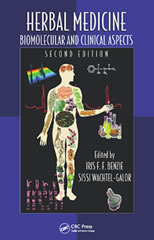
Authors : Benzie Iris - Wachtel-Galor Sissi
Title : Herbal medicine Biomolecular and clinical aspects
Year : 2011
Link download : Benzie_Iris_-_Wachtel-Galor_Sissi_-_Herbal_medicine.zip
Series Preface. During evolution, oxygen—itself a free radical—was chosen as the terminal electron acceptor for respiration; hence, the formation of oxygen-derived free radicals is a consequence of aerobic metabolism. These oxygen-derived radicals are involved in oxidative damage to cell components inherent in several pathophysiological situations. Conversely, cells convene antioxidant mechanisms to counteract the effects of oxidants in either a highly specific manner (e.g., by superoxide dismutases) or a less-specific manner (e.g., through small molecules such as glutathione, vitamin E, and vitamin C). Oxidative stress, as defined classically, entails an imbalance between oxidants and antioxidants. However, the same free radicals that are generated during oxidative stress are produced during normal metabolism and, as a corollary, are involved in both human health and disease by virtue of their involvement in the regulation of signal transduction and gene expression, activation of receptors and nuclear transcription factors, antimicrobial and cytotoxic actions of immune system cells, and aging and age-related degenerative diseases. In recent years, research disciplines focusing on oxidative stress have increased our knowledge of the importance of the cell redox status and the recognition of oxidative stress as a process with implications for many pathophysiological states. From this multi- and interdisciplinary interest in oxidative stress emerges a concept that attests the vast consequences of the complex and dynamic interplay of oxidants and antioxidants in cellular and tissue settings. Consequently, our view of oxidative stress is both growing in scope and following new directions. Likewise, the term “reactive oxygen species,” adopted at some stage to highlight nonradical/radical oxidants, now fails to reflect the rich variety of other species in free-radical biology and medicine, encompassing nitrogen-, sulfur-, oxygen-, and carbon-centered radicals. These reactive species are involved in the redox regulation of cell functions and, as a corollary, oxidative stress is increasingly viewed as a major upstream component in cell-signaling cascades involved in inflammatory responses, stimulation of cell adhesion molecules, and chemoattractant production and as an early component of age-related neurodegenerative disorders such as Alzheimer’s, Parkinson’s, and Huntington’s diseases, and amyotrophic lateral sclerosis. Hydrogen peroxide is probably the most important redox-signaling molecule that, among others, can activate nuclear factor κB (NF-κB), NF-E2 related factor 2 (Nrf2), and other universal transcription factors, and that is involved in the redox regulation of insulin and mitogen-activated protein kinase (MAPK) signaling. These pleiotropic effects of hydrogen peroxide are largely accounted for by changes in the thiol/disulfide status of a cell, an important determinant of the cell’s redox status with clear involvement in adaptation, proliferation, differentiation, apoptosis, and necrosis. The identification of oxidants in the regulation of redox cell signaling and gene expression is a significant breakthrough in the field of oxidative stress. The classical definition of oxidative stress as an imbalance between the production of oxidants and the occurrence of antioxidant defenses now seems to provide a limited depiction of oxidative stress, although it emphasizes the significance of cell redox status. Because individual signaling and control events occur through discrete redox pathways rather than through global balances, a new definition of oxidative stress was advanced by Dean P. Jones as a disruption of redox signaling and control that recognizes the occurrence of compartmentalized cellular redox circuits. These concepts are anticipated to serve as platforms for the development of tissue-specific therapeutics tailored to discrete, compartmentalized redox circuits. This, in essence, dictates the principles of drug development–guided knowledge of the mechanisms of oxidative stress. Hence, successful interventions will take advantage of new knowledge of compartmentalized redox control and free-radical scavenging. ...

Demolins Edmond - L'éducation nouvelle
Auteur : Demolins Edmond Ouvrage : L'éducation nouvelle Année : 1898 Lien de téléchargement :...














